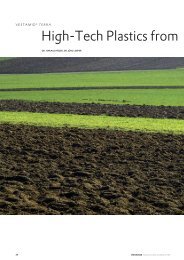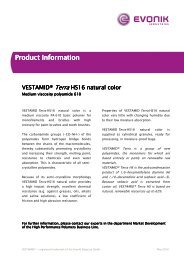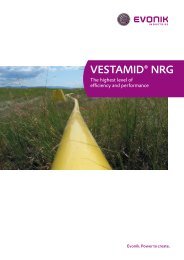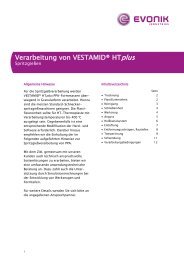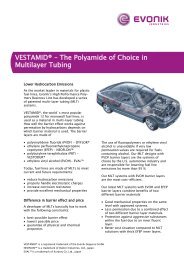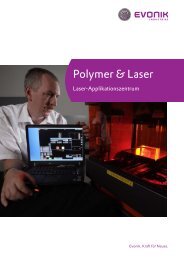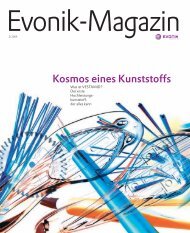VESTAMID® D
VESTAMID® D
VESTAMID® D
You also want an ePaper? Increase the reach of your titles
YUMPU automatically turns print PDFs into web optimized ePapers that Google loves.
VESTAMID® DPolyamide 612 compounds
Evonik, the creative industrial group from Germany, is one of the worldleaders in specialty chemicals. Its activities focus on the key megatrendshealth and nutrition, resource efficiency and globalization. Evonik isactive in over 100 countries around the world.Together with the Acrylic Monomers and Acrylic Polymers BusinessLines, the High Performance Polymers Business Line is part ofthe Performance Polymers Business Unit. It specializes in customizedproducts, product systems and semi-finished products based on highperformance polymers. Our plastics have proven their worth in theautomotive, communications and electrical and electronics industries,and in the engineering, sports and leisure for approximately 40 years.Due to their excellent properties the PA 612 compounds of theVESTAMID® D series represent specialty products that complement thecomprehensive selection of PA 12 compounds of the VESTAMID® Lseries. In addition they are suitable for high-quality plastic-rubbercomposites.2
Contents1.0 Overview of PA 612 compounds and their applications ............................... 41.1 PA 612 compounds and their applications .................................................... 41.2 Nomenclature .............................................................................................. 61.3 Delivery and coloring .................................................................................. 71.4 Processing ................................................................................................... 82.0 General properties ....................................................................................... 92.1 Physiological and toxicological evaluation .................................................... 92.2 Environmental impact and safety ............................................................... 102.3 Influence of temperature on the mechanical properties ............................. 112.4 Long-term properties of PA 612 under load .............................................. 132.5 Influence of ambient humidity ................................................................... 162.6 Resistance to chemicals ............................................................................. 182.7 Abrasion behavior. ..................................................................................... 183.0 Plastics-rubber (K&K) composites without adhesives ................................. 194.0 Comparative tables of compounds ............................................................ 203
1.0 Overview of PA 612 compoundsand their applicationsEvonik’s High Performance PolymersBusiness Line manufactures a range ofpolyamide 612 (PA 612) compounds,which are supplied under the registeredtrademark VESTAMID® D.PA 612 is the polycondensation productof 1,6-hexamethylene diamine and1,12-dodecanedioic acid (1,10-decanedicarboxylic acid):H 2 N-(CH 2 ) 6 -NH 2 + HOOC-(CH 2 ) 10 -COOH →[NH-(CH 2 ) 6 -NH-CO-(CH 2 ) 10 -CO] nThe carbonamide groups (-CO-NH-) ofthe polyamides form hydrogen bridgebonds between the chains of the macromolecules,thereby substantially promotingcrystallinity and increasing theirstrength, melting point, resistance tochemicals, and even water absorption.This is characteristic of all semi-crystallinepolyamidesPolyamide 12 has the lowest carbonamidegroup concentration of all commerciallyavailable polyamides, giving itthe lowest moisture absorption andlargest dimensional stability of parts inchanging conditions of ambient humidity.In polyamide 612, the concentrationis slightly higher but still well belowthat of polyamide 6 or polyamide 66.Molded parts made of polyamide 612consequently share, nearly unchanged,the same characteristics that are prizedin PA 12 molded parts:• high impact strength• very good resistance to greases, oils,fuels, hydraulic fluids, water, alkalis,and saline solutions• very good stress cracking resistance,even when subjected to chemical attackand when used to cover metalparts• low coefficients of sliding friction andhigh abrasion resistance, even whenrunning dryIts advantages over PA 12 exhibit in the• heat deflection temperature (meltingpoint nearly 40 °C higher)• tensile and flexural strength• outstanding recovery at high wetstrengthThe PA 612 compounds of theVESTAMID® D series consequently representspecialty products that complementthe comprehensive selection of PA 12compounds of the VESTAMID® L series.Like all high-performance plastics of theHigh Performance Polymers BusinessUnit, VESTAMID® compounds satisfythe highest quality standards. Our systemfor quality assurance is certified accordingto ISO 9001:2008. In severalaudits conducted by our customers, thisquality management system receivedexcellent ratings.4
1.1 PA 612 compoundsand their applicationsThe PA 612 product line logically complementsthe comprehensive offering ofour PA 12 compounds. The table providesan overview about the characterizationof our products and their typicalapplications. More detailed informationabout most of our compounds is containedin the comparative tables inchapter 4. For information about newor special products please ask the indicatedcontacts.Other properties of VESTAMID® 612compounds and material information onthe other products of the High PerformancePolymers Business Lines are containedin the plastics database Campus®*),which is updated regularly. You willfind Campus on the Internet at www.vestamid.com > Products & Services*) Campus® is the registered trademark of CWF GmbH/Frankfurt (Main).PA 612 compounds and their typical applicationsVESTAMID®CharacterizationRecommendedfor K&Kcomposite 2)Processingmethod 3)Tensilemodulus[MPa] 4)Designationaccording toISO 1874-1ApplicationsD16 low-viscosity base product IM, E 2200 PA612, LN, 12-020monofilaments, bristles with highrecovery for paint brushes andtooth brushesD18medium-viscosity baseproduct IM, E 2200 PA612, LN, 14-020monofilaments, bristles with highrecovery for paint brushes andtooth brushesD22 high-viscosity base product IM, E 2200 PA612, LN, 18-020monofilaments, bristles with highrecovery for paint brushes andtooth brushes, abrasive bristles,pipesD26 high-viscosity base product E 2200 PA612, LN, 22-020 monofilamentsDX9300low-viscosity,heat-stabilized,with improved releaseproperties IM 2100 PA612, MHR, 12-020 retainers for quick connectorsDX9322 1)15% ground-glass fiberreinforced, heat-stabilized + IM 3150PA612, MH, 14-030,GF15low-warpage housings, coveringswith sprayed-on elastomer sealsX7099 1)20% glass fiber reinforced,heat-stabilized + IM 5600PA612, MH, 14-050,GF20housings, sealing and damping elementsfor the automotive industry,noise and vibration-dampingsliding bearings and rollersDX9321 1)DX9323 1)impact-resistant, 20% glassfiber reinforced,heat-stabilized + IM 5700impact-resistant, 35% glassfiber reinforced,heat-stabilized + IM 8900PA612-HI, MH,14-050, GF20 housings, coveringsPA612-HI, MH,14-090, GF35 plastic-rubber compositesDX9325 1)40% glass fiber reinforced,heat-stabilized + IM 9400PA12, MH, 14-100,GF40plastic-rubber compositesDX9302 1)elastomer modified,heat-stabilized E 1150 PA612-HI, EH, xx-010low-extract windshield wiperlines, corrugated pipesDX9304 1)impact-resistant, heat- andlight-stabilized E 1800PA612-HI, EHL,18-020tubing systems subjected to highertemperatures, e.g., hydraulicclutch linesDX9305 1) heat- and light-stabilized E 2250 PA612, EHL, 22-020 same as DX9304EX9350 1) elastomer modified E 600PA612, PPGD, EHL,18-005 vacuum brake booster lines1) currently only available in black, light-stable due to carbon black, 2) Plastic-rubber composite, 3) IM = Injection Molding; E = Extrusion, 4) measured dry/freshly molded5
1.2 NomenclatureDevelopment productsVESTAMID® compounds are dividedinto sales and development products.The composition and manufacturingmethods of sales products have beenestablished on the basis of extensiveexperience and wide acceptance, andthese products have a systematic nomenclature.In the case of developmentproducts, formulations are still subjectto change so that they can be optimizedfor particular applications.Development products are created forparticular applications. We optimizethese products using the experiencethat we have gained during market introduction.This may result in slightchanges to the formulations and manufacturingprocesses. We immediatelynotify the affected customers aboutmodifications and inform them aboutany possible impact on specifications oron quality.Sales productsStandard sales products in theVESTAMID® 612 series are named withthe letter D, identifying dodecanedioicacid as the monomer base. For unfilledstandard products, the next two digitscorrespond to one tenth of the averageviscosity number (J value) measured inm-cresol in accordance with ISO 307.The standard also permits the measurementto take place in 96-percent sulfuricacid instead of m-cresol. Althoughthe two values differ, they correlatestrongly* (see Figure). We do not providemelt flow rates (MFR, MVR), becausepolyamides have to be viewed as“living polymers” under the specifiedtest conditions. Even minimum watercontents in the resins will cause themelt flow rates to become highly variableand non-reproducible without affectingthe solution viscosity. In general,the higher the J value (and the twodigits in the product name), the higherthe molecular weight, melt viscosity,and impact strength can be expectedto be.The final component of the name is thecolor. Example: VESTAMID D16 naturalcolor.VESTAMID® development productsbased on PA 612 are named with theletters DX, followed by a four-digitnumber. The number has no specificmeaning in regard to the compositionor properties of the product.Example: Test product, nomenclatureVESTAMID® DX9300 natural colorJ K(m-cresol) [ml/g]Comparison of the viscosity numbers J,measured in m-cresol and sulfuric acidaccording to ISO 3073002502001501005050 100 150 200 250J S(sulfuric acid) [ml/g]Experimental testing with VESTAMID®*) In the quality test, we only measure the solution viscosityin m-creosol6
1.3 Delivery and coloringVESTAMID® D compounds are deliveredas a dry, ready-to-process granulate inmoisture-proof bags with a net weightof 25 kg. By mutual agreement we alsodeliver VESTAMID® D in 1,000 kg octabins.The storage time of unopenedpackaging is almost unlimited under ordinarystorage conditions, unless thepackaging is damaged. The storagetemperature should not exceed 45 °C,especially in the case of plasticized resins.Similar to other semi-crystalline polyamides,unmodified VESTAMID® iscolorless when molten and whitish-opaquein its solid state (naturalcolors). VESTAMID® can generally becolored as desired although some specialadditives may cause restrictions.Most compounds are supplied in theirnatural colors or as black. Others, suchas compounds that have been modifiedwith graphite, have unique colors dueto their additives. Colorants containinglead and cadmium are essentially notused.In appropriate lot sizes, speciallycolored compounds can be delivered.Please contact the indicated persons foradditional information.VESTAMID® compounds can also becolored during processing. The preferredmethod is by using masterbatches based on PA 612. Dry coloringby tumbling with powdered colorants ina mixer is also possible but inconvenient.Pneumatic conveyance is thenruled out. Colorant pastes or colorantconcentrates with a “neutral” base (e.g.,polyethylene) may be incompatible withPA 612, ultimately leading to parts withpoor characteristics (inhomogeneouscolor distribution or mechanical failure).Therefore, the compatibility of the colorantpaste must definitely be pretested.Our experts will be appreciated to giveyou additional information and support.7
1.4 ProcessingViscosity curves, T = 260 °CPA 612 compounds may only be processedin a dry state at a water contentbelow 0.1%. If this rule is not followed,decomposition and irreversible damageduring processing is to be expected.Detailed information about the handlingand processing of VESTAMID® productsand about machine design can be foundin the brochure “Handling and Processingof VESTAMID®.”10 410 3Chapter 1.2, Nomenclature, alreadymentioned the fundamental interrelationshipbetween viscosity number andmelt viscosity. The figures show the relationshipsfor 260 °C, using thelow-viscosity resin VESTAMID® D16,the medium-viscosity resin VESTAMID®D18, and the high-viscosity resinVESTAMID® D22 as examples.Viscosity [Pa s]10 210 1 0 1 10 100Circle frequency [1/s]The curve for the reinforced resinVESTAMID® X7099 illustrates the influenceof 20% glass fibers on the meltviscosity. If necessary, the different viscositylevels can be balanced in theconventional manner by adapting theprocessing temperature.VESTAMID® D22 VESTAMID® X7099 VESTAMID® D18 VESTAMID® D16Dependence of the melt viscosity on the solution viscosity (260 °C at 10/s)10 4VESTAMID® D22VESTAMID® X709910 3VESTAMID® D18Melt viscosity [Pa s]VESTAMID® D1610 2 140 150 160 170 180 190 200 210 220 230 240Viscosity number J [ml/g]8
2.0 General properties2.1 Physiological and toxicologicalevaluationThe Environment, Health, Safety &Quality Department, which is responsiblefor the High Performance PolymersBusiness Line, provides general informationon the toxicological propertiesof VESTAMID® compounds and relevantanalysis pertaining to their contact withfoodstuffs. The department is also responsiblefor providing informationabout product safety and producing theEU Safety Data Sheets for VESTAMID®.Please direct all questions on the subjectto the indicated contacts.Food contact – EU statusFollowing the harmonization of Europeanlaws and ordinances, new regulationshave come into effect regardingplastics intended to come into contactwith foodstuffs. Commission Regulation(EU) No 10/2011 is valid from Mai 1,2011.The VESTAMID® D base grades of thePA 612 series such as VESTAMID® D16,D18, D22, and D26 are approved in theEuropean Union for food contact becausethe base monomers hexamethylenediamineand decanedioic acid andused additives are on the positive list inCommission Regulation (EU) No10/2011. A migration limit of 2.4 milligramsper kilogram food has beenspecified for hexamethylenediamine,which must be tested and compliedwith on the finished article itself.Food contact – FDA statusUnder 21 CFR §177.1500 (Nylon Resins)of the FDA, PA 612 is approved inthe U.S. for articles for repeated use incontact with food up to a maximumtemperature of 100°C. The restrictionsof paragraph b(8) must be observed,however. Cold sterilization is permitted.Medical applicationsFor use of materials in medical applications,Directive 93/42/EEC applies inthe European Union; this was transposedinto German law as the MedicalDevices Act in August 1994. The approvalprocedure is regulated in detailby the corresponding international andnational standards such as ISO 10993and DIN EN 30993-1. In individualcases, the regulations in the currentGerman Pharmacopoeia (DAB) and theEuropean Pharmacopoeia can also beused to aid in the assessment. In casesof doubt, the moldings or semi-finishedproducts must be investigated by themanufacturer or user under actual usageconditions.Our experts can provide you informationabout their experiences with variousapproval processes.9
2.2 Environmental impact and safetyVESTAMID® compounds are non-toxicsubstances that do not constitute anyhazard to water and are not governedby any particular safety regulations.They can be disposed of in landfills orincinerated as normal household wastein accordance with local ordinances. Recyclingis, however, preferred and advisablefor economic reasons. Furtherinformation can be obtained from theEU safety data sheets for theVESTAMID® grades.VESTAMID® compounds containingflame retardants do not contain polybrominatedbiphenyls or diphenylethers.No pigments or additives containingcadmium are used.No dangerous by-products are formedif VESTAMID® is processed correctly.Care should be taken, however, to ventilatethe working area properly, as it isrequired when processing thermoplastics– especially for compounds containingflame retardants or plasticizers.Detailed directions about handlingVESTAMID® products can be found inthe brochure “Handling and Processingof VESTAMID®.”Degradation of the material during processingis shown by a discoloration ofthe melt. Degraded material should bequickly removed from the machine andcooled under water, in order to minimizeany troublesome smells.Most VESTAMID® compounds are combustible.Flammable gases are releasedat melt temperatures above 350 °C.Combustion with sufficient air supplyproduces carbon monoxide (CO), carbondioxide (CO 2 ), water (H 2 O), andnitrogen-containing compounds as endproducts. Since the spectrum of crackand combustion products greatly dependson the combustion conditions, itis not possible to make any generalstatements here.10
2.3 Influence of temperature on themechanical propertiesCurves of the dynamic shear modulusand of the loss factor tan , which areobtained from torsional vibration analysis,provide a first glance at the dependenceof the mechanical propertiesof unreinforced and reinforcedVESTAMID® 612 compounds on temperature.In the figure, it can be clearlyseen that PA 612 resins have a higherstiffness than PA 12 resins and thattheir higher melting point has causedtheir drop in strength to shift significantlytoward higher temperatures. Thespecial position of VESTAMID® DX9302is visible: this specially modified resin isclearly more flexible and tougher thanunmodified PA 612 up to -50 °C, makingit the better choice for flexibletubing.The figure on page 12 shows the influenceof temperature on the stress-strainbehavior. The shape of the curve forVESTAMID® D16 is representative of allunreinforced PA 612 compounds.Plots of the thermal expansion and coefficientsof thermal expansion provideinformation about the dimensionalchanges caused by temperature. Thecurves for VESTAMID® DX9300 arerepresentative for our unfilled PA 612resins (D16, D18, D22, D26). The tablesin chapter 4 also list the averagecoefficients of thermal expansion in thetemperature range of 23 °C to 55 °C.If the exposure to extreme temperaturesis brief, then the above changesare reversible, with the possible exceptionof post-shrinkage caused by processing.If components are subjected tothermal stress in the presence of oxygen(air) for a long time, then it is pos-sible that irreversible aging could graduallyoccur, depending on the durationand temperature. Like any other plastic,VESTAMID® will eventually becomebrittle under such conditions. With theexception of the base products, heataging inhibitors are added to allVESTAMID® 612 resins to stabilizethem against the long-term action ofheat. In general, processors will addflexible application-oriented stabilizerconcentrates to the base productsVESTAMID® D16, D18, D22, and D26as necessary during the thermoplasticmolding. We can provide advice aboutthe choices upon request.Torsional vibration analysis according to ISO 6721G’10 210 3Dynamic shear modulus G´[MPa]10 110 010 310 2tan δ-200-150-100-50050 100 150 200 25010 110 0Dissipation factor tan δTemperature [°C]VESTAMID® X7099 VESTAMID® DX9320 VESTAMID® D16 VESTAMID® DX9302 comp. with PA 12 (VESTAMID® L2140)11
Stress-strain plots from tensile tests according to ISO 5276050VESTAMID® D16 nf (tr.)4030Stress σ [MPa]201000Strain ε [%]5101523 °C60 °C100 °CCoefficient of thermal expansion according to ISO 11359254,0Thermal expansion ε [% ]2015105-0-5-10-15-120 -80Temperature [°C]-40VESTAMID® DX93000 40 80 120 1603,53,02,52,01,51,00,50Coefficient of thermal expansion [10 -4 /K]Expansion: transverse longitudinal Coefficient: transverse longitudinalCoefficient of thermal expansion according to ISO 11359254,0Thermal expansion ε [% ]2015105-0-5-10-15-120 -80Temperature [°C]-40VESTAMID® X7099VESTAMID® DX93210 40 80 120 1603,53,02,52,01,51,00,50Coefficient of thermal expansion [10 -4 /K]Expansion: transverse longitudinal Coefficient: transverse longitudinal12
2.4 Long-term properties of PA 612under loadAt elevated temperatures, thermoplasticsbegin to flow or creep under theinfluence of stresses, especially whenthey are unreinforced. PA 612 has a relativelylow tendency to creep, but thedesigner must still take creep resistanceinto consideration because it declinesunder continuous load in comparisonwith short-term stability. On the otherhand, this also means that the initialstress will drop when the strain is heldconstant. Characteristics necessary todesign parts can be taken from the followingfigures, which plot the results oftensile creep tests performed in accordancewith ISO 899.VESTAMID® X7099 black V307171: Tensile creep test according to ISO 899Creep curves, test conditions 23 °C, 50% r. h.10 150,039,510 029,018,5strain [%]8,0load [MPa]10 -1 10 0time [h]10 110 2 10 3Tensile creep modulus curves, test conditions 23 °C, 50% r. h.10 4creep modulus E c[MPa]8,018,529,039,550,0load [MPa]10 3 10 0time [h]10 110 2 10 313
VESTAMID® D16: Tensile creep modulus curves according to ISO 899Test conditions 23 °C, 50% r. h.10 35811creep modulus E c[MPa]1417load [MPa]10 2 10 0time [h]10 110 2 10 3Test condition 60 °C10 3creep modulus E c[MPa]10 2 10 0 10 110 2 10 32357time [h]load [MPa]Test condition 100 °C10 3creep modulus E c[MPa]2357load [MPa]10 2 10 0time [h]10 110 2 10 314
VESTAMID D16: Tensile creep curves according to ISO 899Test conditions 23 °C, 50% r. h.10 117141110 085strain ε [%]load [MPa]10 -1 10 0time [h]10 110 2 10 3Test conditions 60 °C10 17510 032strain ε [%]load [MPa]10 -1 10 0time [h]10 110 2 10 3Test conditions 100 °C10 175310 02strain ε [%]load [MPa]10 -1 10 0time [h]10 110 2 10 315
2.5 Influence of ambient humidityIn contrast to PA 6 and 66, PA 612 absorbsvery little moisture (see figureson page 17), although it absorbs slightlymore than PA 12. It will absorb about1% water in a standard operating environmentof 23°C / 50% relative humidity,and about 2.7% when stored inwater. These values are correspondinglylower for filled or glass fiber reinforcedresins. Absorption of 1% water causes avolume increase of approximately 0.9%,which corresponds to a change in lineardimension of 0.2–0.3%.When the product is stored in water,moisture absorption rises with risingtemperature. At temperatures above80 °C, however, components will dryout again in air so the values of the dryparts will have an effect in this case.Above 0 °C, the absorbed water actslike a small amount of plasticizer. Thismeans that strength and stiffness willdrop somewhat and that impact strengthand tendency to creep will increaseslightly (compare the detailed tables inchapter 4).Since water absorption is very small,the changes in the electrical parametersat room temperature are also low: thegood insulating properties and dielectricstrength remain practically unaltered.The effect of water is most recognizableon the slope of the loss factor tan .16
Water absorption of various polyamideswater absorption [weight-%] PA 66 PA6 PA 612 PA12121086420water absorption at saturation water absorption at 23 °C / 50% r. h.Influence of the water content on the tensile modulus of different polyamidestensile modulus [MPa] PA 66 PA6 PA 612 PA123500300025002000150010005000freshly moldedconditioned at 23 °C / 50% r. h.Influence of water content on the tensile strength of different polyamidestensile strength [MPa] PA 66 PA6 PA 612 PA129080706050403020100freshly moldedconditioned at 23 °C / 50% r. h.17
2.6 Resistance to chemicalsThe chemical resistance of PA 612 iscomparable to that of PA 12. Polyamide612 generally displays outstanding resistanceto fuels, lubricants, greases,oils, and most industrial solvents. Polarsolvents can cause reversible swelling,especially at elevated temperatures.This will generally be connected with adrop in strength (plasticizer effect). Inpractice, the original characteristics willbe restored after the solvent has evaporated.Liquids that have a particularly high affinityto the carbonamide groups of thepolyamides can act as solvents for PA612 at higher temperatures. Examplesare phenols, cresols, benzyl alcohol, andparticular chlorohydrocarbons.2.7 Abrasion behaviorPolyamides have very high abrasion resistance.This can be determined accordingto DIN 53754 (Taber) or DIN53516. The test consists of abrasionfrom emery grinding. The table showssome typical values and also indicatesthe effect of fillers and reinforcingmaterials.For bearings or sliding parts, the coefficientof sliding friction is more importantthan abrasion. This coefficient islow and is comparable to that of PA 12.Since PA 612 is very resistant to greasesand lubricants, it is a good material forproducing maintenance-free bearings.Due to their low water absorption,PA 612 compounds exhibit very goodresistance to aqueous agents, such asalkali solutions, saline solutions, andcleaners. Their resistance to aqueousacids is limited, depending on the temperature,time, and concentration. Ingeneral, concentrated acids will lead toa more or less rapid drop in relativemolar mass (embrittlement). Concentratedsulfuric acid and formic acid willdissolve PA 612.Abrasion of PA 612 resinsVESTAMID®ModificationAbrasion according to the Taberabrasion test, DIN 53754, at23 °C [mg / 100 revolutions]DX9300 – 15DX9322 15% ground glass fibers 7 - 8DX9321, X7099 20% chopped strands 1018
3.0 Plastics-rubber compositeswithout adhesivesSeveral of the VESTAMID® D compoundshave been specially developedto form a direct bond with selectedx-NBR, HNBR, FPM, AEM, ACM,VMQ and EPDM rubbers. This utilizes aplastic-rubber composite process (K&Kprocess), which Evonik has patentedand which is particularly economicaland environmentally friendly. The rubberis first sprayed directly onto moldingsof PA 612, without pretreatmentor adhesion promoters. A permanentchemical thermoplastic-elastomer compositewill then occur during the succeedingperoxide vulcanization step.In addition to the VESTAMID® D productgroup, resins based on PPE(VESTORAN®) and PPA (VESTAMID®HTplus) are available to which the plastic-rubbercomposite process can successfullybe applied. The figure illustratesthe major processing steps.Detailed information is also provided inthe brochure “High performance polymersin plastic-rubber composites” orcan be obtained from our experts. Theycan give you advice about selectingsuitable composite partners. Please directyour questions on the subject tothe indicated contacts.Process diagram of the plastic-rubber composite processManufacturingof the hardcomponentTemporarilystorageDegreasingApplication of aprimer and/oran adhesiveDryingApplying andvulcanizingof the rubberConventional processK&K composite in a two-step processK&K composite in a one-step process19
4.0 Comparative tables of the compounds4.1 Unfilled PA 612 compoundsProperty Test method Unit VESTAMID®D16 D18 D22after pretreatmentdry/freshlydry/freshlydry/freshlymolded conditioned 1) molded conditioned 1) moldedPhysical, thermal, and mechanical properties and flammabilityDensity 23 °C ISO 1183 g/cm 3 1.06 1.06 1.06 1.06 1.06Melting temperature ISO 11357peak temperature, 2. heating °C 215 215 215 215 215Heat deflection temperature under load 2) ISO 75-1/-2method A 1.8 MPa °C 65 (75) 55 60 (75) 55 60 (75)method B 0.45 MPa °C 150 (170) 150 (170) 140 (170) 140 (170) 140 (170)Vicat softening temperature ISO 306method B 50 N °C 180 180 180 180 180Coefficient of linear thermal expansion 23-55 °C ISO 11359 10 -4 K -1 1.3 - 1.3 - 1.3Flammability acc. UL94 IEC 606951.6 mm HB HB HB HB HB3.2 mm HB HB HB HB HBWater absorption 23 °C, saturation % 2.6 - 2.7 - 2.7Mold shrinkage23 °C, 50% r. h. ISO 62 % 1.0 - 1.0 - 1.0specimen127x12.7x3.2 mm 3)in flow directionprocessing acc. to% 1.4 - 1.3 - 1.3in transverse direction ISO 1874-2 % 1.0 - 1.1 - 1.1Tensile testISO 527-2/1AStress at yield MPa 58 53 60 52 60Strain at yield % 5 16 4 20 4Strain at break % > 50 > 50 > 50 > 50 > 50Tensile modulus ISO 527-2/1A MPa 2200 1700 2200 1700 2200CHARPY-impact strength 3)CHARPY-notched impact strength 3)ISO 179/1eU23 °C kJ/m 2 N N N N N-30 °C kJ/m 2 N N N N NISO 179/1eA23 °C kJ/m 2 5C 6C 6C 9C 7C-30 °C kJ/m 2 6C 6C 6C 7C 7CElectrical propertiesRelative permittivity IEC 60250100 Hz 3.8 4.5 3.8 - 3.81 MHz 3.2 4.1 3.4 - 3.0Dissipation factor IEC 60250100 Hz 10 -4 240 590 260 - 2301 MHz 10 -4 290 510 310 - 290Dielectric strength K20/P50 IEC 60243-1 kV/mm 28 27 28 - 27Comparative tracking index CTI IEC 60112test solution A 50 drops value > 600 > 600 > 600 - > 600Volume resistivity IEC 60093 Ohm cm 10 15 10 14 - - 10 15Electrolytic corrosion effect IEC 60426 step A1 A1 A1 A1 A11)conditioned at 23 °C / 50% relative humidity to constant weight2)measured freshly molded; values in parenthesis after conditioning at 180 °C / 60 min3)N = no break, P = partial break, C = complete break incl. hinge break H20
DX9300 DX9302 * ) D26 DX9304 * ) DX9305 * )conditioned 1)dry/freshlydry/freshlydry/freshlydry/freshlydry/freshlymolded conditioned 1) molded conditioned 1) molded conditioned 1) molded conditioned 1) molded conditioned 1)1.06 1.06 1.06 1.02 1.02 1.06 1.06 1.04 - 1.06 -215 215 215 215 215 215 215 213 - 213 -55 65 (75) 55 50 - 70 (75) - 50 (55) - 60 (70) -140 (170) 155 (170) 155 (170) 140 - 180 (190) - 170 (175) - 175 (185) -180 180 180 110 110 185 - 175 - 185 -- 1.3 - 1.7 - 1.5 - 1.5 - 1.4 -HB HB HB HB - HB - HB - HB -HB HB HB HB - HB - HB - HB -- 2.6 - 2.2 - 2.7 - 2.7 - 2.7 -- 1.0 - 0.5 - 1.0 - 1.0 - 1.0 -**) **) **)- 1.1 - 1.9 - 1.6 - 2.2 - 1.8 -- 1.5 - 1.4 - 1.5 - 1.4 - 1.2 -49 59 52 30 26 60 49 50 41 60 4920 5 20 15 23 4.2 4.4 5.0 20 4.3 18> 50 > 50 > 50 > 50 > 50 > 50 > 50 > 50 > 50 > 50 > 501700 2100 1700 1150 850 2200 1700 1800 1200 2250 1500N N N N N N N N N N NN N N N N N N N N N N10C 6C 8C 90P 100P 8C 9C 50P 95P 6C 10C6C 6C 6C 19C 17P 7C 7C 30C 18C 6C 7C5.0 4.0 - 3.8 - 4.4 - 4.1 - 4.3 -3.7 2.9 - 3.0 - 3.2 - 3.2 - 3.3 -650 440 - 470 - 590 - 560 - 550 -550 330 - 370 - 380 - 310 - 320 -27 29 - 41 - 22 - 24 - 23 -> 600 > 600 - > 600 - > 600 - > 600 - > 600 -10 14 10 14 - 10 14 - 10 14 - 10 13 - 10 13 -A1 A1 A1 AN 1,2 - AN 1,2 - AN 1,2 - AN 1,2 -* ) available only in black color**)measured at specimen 60x60x2mm, ISO 294-421
4.2 Filled and reinforced PA 612 compoundsProperty Test method Unit VESTAMID®with fillers/reinforcing materialsafter pretreatmentPhysical, thermal, and mechanical properties and flammabilityDX9322 *)(15% ground glass fibers)X7099 *)(20% glass fibers)DX9321 *)(20% glassdry/freshlydry/freshlydry/freshlymolded conditioned 1) molded conditioned 1) moldedDensity 23 °C ISO 1183 g/cm 3 1.17 1.17 1.20 1.20 1.19Melting temperature, peak temperature, 2. heating ISO 11357 °C 215 215 215 215 215Heat deflection temperature under load ISO 75-1/-2method A 1.8 MPa °C 114 114 190 190 189method B 0.45 MPa °C 186 186 210 210 208Vicat softening temperature, method B 50 N ISO 306 °C 194 193 205 205 207Coefficient of linear thermal expansion 23-55 °C ISO 11359transverse 10 -4 K -1 1.0 - 0.5 - 0.5longitudinal 10 -4 K -1 0.6 - 0.7 - 0.7Flammability acc. UL94 IEC 606951.6 mm HB HB HB HB HB3.2 mm - - HB - -Water absorption 23 °C, saturation ISO 62 % 2.4 - 2.0 - 2.023 °C, 50% r. h. % 0.9 - 0.8 - 0.8Mold shrinkagein flow directionspecimen127x12.7x3.2 mmprocessing acc. to% 1.9 - 0.6 - 0.7in transverse direction ISO 1874-2 % 0.9 - 1.1 - 0.9Tensile testISO 527-2/1AStress at yield MPa 63 53 - - -Strain at yield % 8 12 - - -Stress at break MPa 59 47 118 - 115Strain at break % 18 23 5 - 5Tensile modulus ISO 527-2/1A MPa 3150 2650 5600 - 5700CHARPY impact strength 2)CHARPY notched impact strength 2)ISO 179/1eU23 °C kJ/m 2 46C 96C 80C 93C-30 °C kJ/m 2 43C 48C 60C 106CISO 179/1eA23 °C kJ/m 2 4C 5C 10C 18C-30 °C kJ/m 2 3C 3C 7C 11CElectrical propertiesRelative permittivity IEC 60250100 Hz 4.3 - 4.4 - 4.41 MHz 3.1 - 3.9 - 3.1Dissipation factor IEC 60250100 Hz 10 -4 430 - 650 - 5001 MHz 10 -4 493 - 430 - 470Dielectric strength K20/P50 IEC 60243-1 kV/mm - - 38 - -Comparative tracking index test solution A CTI IEC 6011250 drops value > 600 - - - > 600100 drops value 575 - - - 600Volume resistivity IEC 60093 Ohm cm 10 14 - 10 14 - 10 141)conditioned at 23 °C / 50% relative humidity to constant weight2)C = complete break incl. hinge break H22
fibers)conditioned 1)DX9323 *)(35% glass fibers)DX9325 *)(40% glass fibers)dry/freshlydry/freshlymolded conditioned 1) molded1.19 1.33 1.33 1.37215 215 215 212189 196 196 195208 213 213 210207 209 209 -- 0.5 - 0.5- 0.8 - -HB HB HB HB- HB HB HB- 1.9 - 1.9- 0.8 - 0.8- 0.4 - 0.23- 1.0 - 0.890 - - -5 - - -86 148 126 15010 5 5 44700 8900 7400 940093C 90C 86C 100C102C 105C 97C 104C19C 22C 21C 22C11C 15C 14C 16C- 4.8 - -- 3.6 - -- 610 - -- 320 - -- 39 - -- > 600 - -- 575 - -- 10 14 - -* ) available only in black color23
Your technical contactsFrank Lorenz (Automotive, K&K)frank.lorenz@evonik.comPaul-Ludwig Waterkamp (Filaments)paul-l.waterkamp@evonik.comThis information and all technical and otheradvice are based on Evonik’s present knowledgeand experience. However, Evonik assumes noliability for such information or advice, includingthe extent to which such information or advicemay relate to third party intellectual propertyrights. Evonik reserves the right to make anychanges to information or advice at any time,without prior or subsequent notice. Evonik disclaimsall representations and warranties, whetherexpress or implied, and shall have no liability for,merchantability of the product or its fitness fora particular purpose (even if Evonik is aware ofsuch purpose), or otherwise. Evonik shall not beresponsible for consequential, indirect or incidentaldamages (including loss of profits) of anykind. It is the customer’s sole responsibility toarrange for inspection and testing of all productsby qualified experts. Reference to trade namesused by other companies is neither a recommendation,nor an endorsement of the correspondingproduct, and does not imply that similar productscould not be used.Evonik Industries AGHigh Performance Polymers45764 MarlGermanyphone +49 2365 49-9878evonik-hp@evonik.comwww. vestamid.comwww.evonik.com24



